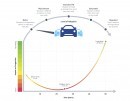Self-driving vehicles are seen as the solution to improve road safety in many countries, and the United Arab Emirates are the latest to view the technology as the key to safer roads.
According to engineering consultancy company Atkins, represented by Lee Woodcock, global product director for intelligent mobility, over 90% of accidents take place because of human error. Since computers and machines have proven they can perform tasks with more reliability than the average person, the same applies to driver-less vehicles.
The favorable opinion regarding autonomous vehicles is shared by Sheikh Mohammed Bin Rashid, Vice President and Ruler of Dubai, who stated last April that he wants driverless transport to handle up to 25% of journeys in the emirate by 2030. At the time of the announcement, a 10-seat driverless vehicle was exhibited at the Mena Transport Congress, and it received approval for a trial run.
According to Lee Woodcock, the Atkins representative that studied the leading causes of traffic accidents, the Middle East has what it takes to be at the forefront of driverless vehicle adoption.
He explained that the mix of over 200 nationalities of people found on the roads, as well as local legislative rules and behavioral attributes suit the introduction of self-driving vehicles, The National notes.
Mr. Woodcook pointed out that the many nationalities living in Dubai do not share the same expectations and norms while driving, and the roads would become safer once human drivers were replaced by self-driving vehicles.
There is also a downside to the introduction of driverless vehicles in Dubai. Many chauffeur jobs might be lost, and engineers still have to integrate self-driving cars in human-designed roads. The biggest challenge for the creators of autonomous vehicles will be human interaction, which may be difficult for both people and computers alike.
The programmers will have the worst job of them all, as they will have to “teach” a vehicle to prepare a backup plan in case other human drivers perform unexpected and unpredictable maneuvers on the road.
The favorable opinion regarding autonomous vehicles is shared by Sheikh Mohammed Bin Rashid, Vice President and Ruler of Dubai, who stated last April that he wants driverless transport to handle up to 25% of journeys in the emirate by 2030. At the time of the announcement, a 10-seat driverless vehicle was exhibited at the Mena Transport Congress, and it received approval for a trial run.
According to Lee Woodcock, the Atkins representative that studied the leading causes of traffic accidents, the Middle East has what it takes to be at the forefront of driverless vehicle adoption.
He explained that the mix of over 200 nationalities of people found on the roads, as well as local legislative rules and behavioral attributes suit the introduction of self-driving vehicles, The National notes.
Mr. Woodcook pointed out that the many nationalities living in Dubai do not share the same expectations and norms while driving, and the roads would become safer once human drivers were replaced by self-driving vehicles.
There is also a downside to the introduction of driverless vehicles in Dubai. Many chauffeur jobs might be lost, and engineers still have to integrate self-driving cars in human-designed roads. The biggest challenge for the creators of autonomous vehicles will be human interaction, which may be difficult for both people and computers alike.
The programmers will have the worst job of them all, as they will have to “teach” a vehicle to prepare a backup plan in case other human drivers perform unexpected and unpredictable maneuvers on the road.







